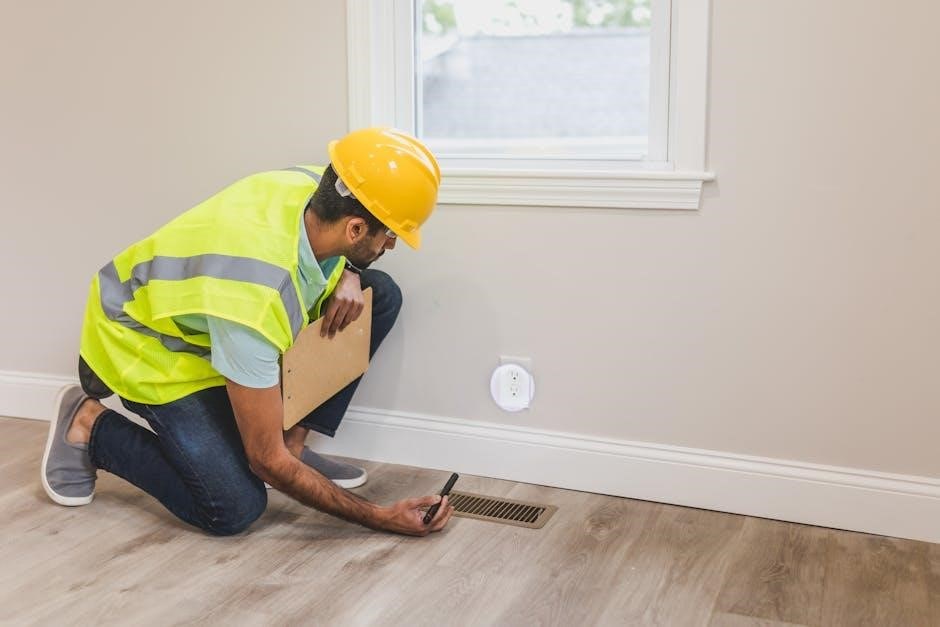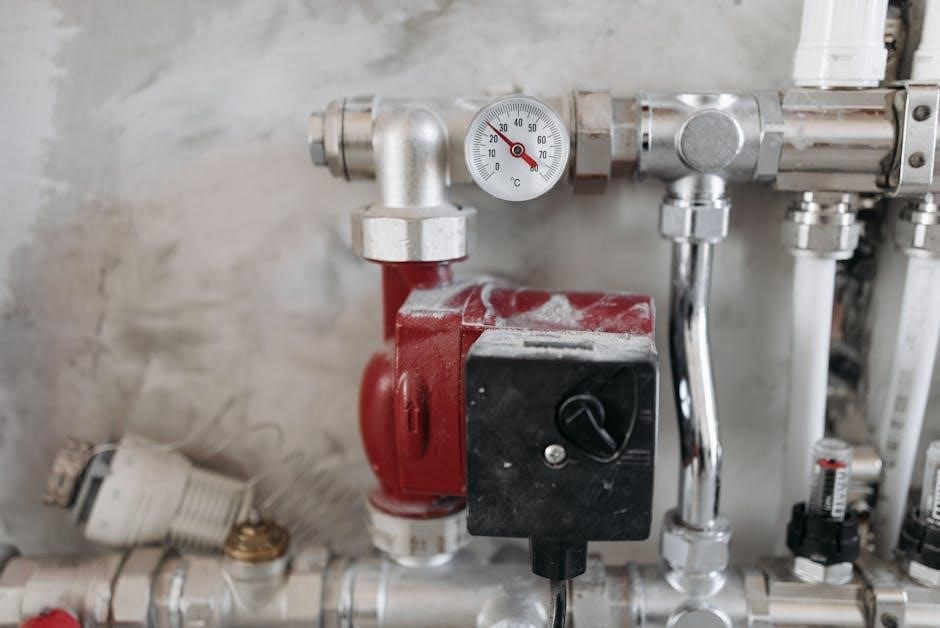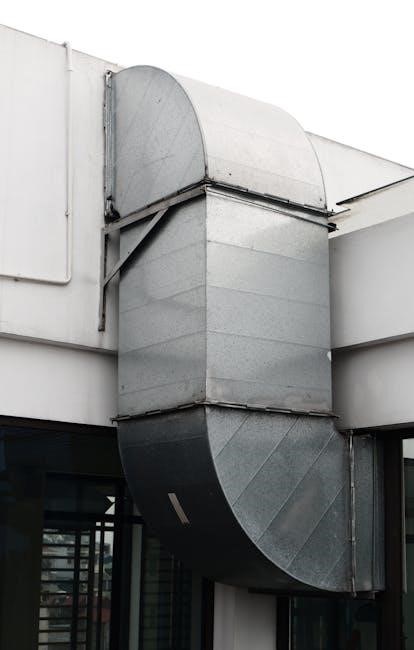
HVAC manifold gauges are essential tools for diagnosing and maintaining heating, ventilation, and air conditioning systems. They measure pressure and temperature, aiding in system performance assessment and troubleshooting.
1.1 What Are HVAC Manifold Gauges?
HVAC manifold gauges are specialized tools used to measure pressure and temperature in heating, ventilation, and air conditioning systems. They consist of two main gauges: one for high-pressure (red) and one for low-pressure (blue) sides of the system. These gauges are connected to the HVAC system via hoses and valves, allowing technicians to monitor refrigerant flow and diagnose issues like leaks or blockages. Understanding how to interpret the readings is crucial for maintaining system efficiency and performance. While they are powerful diagnostic tools, proper training and safety precautions are essential to use them effectively. They are indispensable for HVAC professionals, enabling precise system evaluation and repair.
1.2 Importance of Manifold Gauges in HVAC Systems
Manifold gauges play a vital role in HVAC systems by providing accurate pressure and temperature readings, essential for diagnosing and troubleshooting issues; They help identify low refrigerant levels, blockages, or leaks, ensuring efficient system operation. Technicians rely on these gauges to verify proper system performance, making them indispensable for maintenance and repairs. Additionally, manifold gauges are crucial for charging and evacuating the system, ensuring optimal refrigerant levels. Their ability to detect abnormalities prevents system damage, enhancing overall efficiency and extending equipment lifespan. Proper use of manifold gauges is fundamental for ensuring HVAC systems operate safely and effectively, making them a cornerstone tool in the industry.

Understanding the Components of HVAC Manifold Gauges
HVAC manifold gauges consist of high-pressure (red) and low-pressure (blue) sides, along with hose connections and valves, enabling precise measurement and control of refrigerant flow and system pressure.
2.1 High-Pressure Side (Red Gauge)
The high-pressure side, indicated by the red gauge, measures the pressure in the HVAC system’s discharge line. It provides critical data on the system’s performance, helping identify issues like blockages or overcharging. Proper use of the red gauge ensures accurate pressure readings, essential for diagnosing system malfunctions. Regular monitoring with this gauge helps maintain optimal system operation and prevents potential damage from excessive pressure. Understanding its readings is vital for effective troubleshooting and maintenance, ensuring the HVAC system runs efficiently and safely. Always refer to the manufacturer’s guidelines for interpreting pressure levels accurately. This gauge is indispensable for any HVAC professional or technician.
2.2 Low-Pressure Side (Blue Gauge)

The low-pressure side, represented by the blue gauge, monitors the suction line pressure in an HVAC system. This gauge is crucial for assessing the system’s intake and identifying issues such as low refrigerant levels or blockages. Accurate readings from the blue gauge help technicians diagnose problems like frozen evaporators or malfunctioning compressors. Regular monitoring ensures the system operates within safe pressure ranges, preventing damage and optimizing performance. Understanding the blue gauge’s readings is essential for effective troubleshooting and maintenance, ensuring the HVAC system functions efficiently and reliably. Always consult the system’s specifications for appropriate pressure levels to ensure accurate interpretations and safe operations.
2.3 Hose Connections and Valves
Hose connections and valves are critical components of HVAC manifold gauges, enabling secure links to the system. The hoses are color-coded—blue for low-pressure and red for high-pressure sides. Proper adapters are essential for compatibility with system ports. Valves control the flow of refrigerant, allowing precise pressure measurements. Always ensure tight connections to avoid leaks and maintain accuracy. Using the valves correctly helps isolate the gauges and safely release pressure before disconnection. Regular inspection of hoses and valves is vital for longevity and reliable performance. Proper handling prevents damage and ensures accurate readings, making them indispensable for effective system diagnosis and maintenance. Adapters and valves must align with the system’s specifications for optimal functionality.

Preparing for Using Manifold Gauges

Before using manifold gauges, ensure the HVAC system is powered off and depressurized. Gather necessary tools and adapters, and review safety guidelines to prevent accidents and ensure accurate readings. Proper preparation is key to safe and effective use. Always refer to the system’s manual for specific instructions. Understanding the setup and safety protocols minimizes risks and maximizes efficiency. Take time to familiarize yourself with the equipment and procedures to avoid common mistakes. A well-prepared setup ensures reliable data collection and system maintenance. Safety should never be compromised when handling pressurized systems. Be thorough in your preparation to achieve optimal results. This step is crucial for successful diagnostics and repairs.
3.1 Safety Precautions
When using HVAC manifold gauges, safety is paramount. Always wear protective gear, including safety glasses and gloves, to prevent injury from potential pressure releases. Ensure the system is depressurized before connecting or disconnecting gauges to avoid sudden bursts of refrigerant. Never smoke or use open flames near the system, as refrigerants are flammable. Keep the work area well-ventilated to prevent inhalation of refrigerant fumes, which can be harmful. Be cautious of high-pressure lines and avoid over-tightening connections to prevent damage. Familiarize yourself with emergency procedures, such as evacuating the area if a leak occurs. Regularly inspect hoses and gauges for signs of wear or damage. Proper storage of gauges and hoses when not in use is also essential to maintain their integrity and ensure safe operation. Always follow the manufacturer’s guidelines and industry standards to minimize risks. Safety should never be compromised when working with pressurized systems.
3.2 Gathering Necessary Tools and Adapters
To properly use HVAC manifold gauges, you must gather all necessary tools and adapters. Start with the gauges themselves, ensuring they are compatible with your system’s refrigerant type. You’ll need high-quality hoses with proper fittings to connect to the service ports. Adapters are crucial for connecting gauges to systems with different port configurations. A screwdriver or valve core depressor may be needed to access Schrader valves. Additionally, a vacuum pump and micron gauge are essential for evacuating the system before charging with refrigerant. Always verify that your tools and adapters are compatible with the system’s specifications to ensure safe and accurate operation. Properly organized tools will streamline the process and prevent delays during diagnostics or maintenance.

Connecting the Manifold Gauges to the HVAC System
Connect the low-pressure side (blue hose) to the evaporator coil and the high-pressure side (red hose) to the condenser. Purge hoses to ensure accuracy before use.
4.1 Steps to Connect the Low-Pressure Side
First, locate the low-pressure port, typically marked with an ‘L’ or color-coded blue. Attach the blue hose to the manifold gauge and tighten securely. Open the valve slowly to avoid sudden pressure changes. Ensure the system is powered off and safe to work on. Use appropriate adapters if necessary to fit the port. Double-check the connection for leaks by applying a small amount of soapy water. Once secure, proceed to connect the high-pressure side. Always refer to the HVAC system’s manual for specific instructions, as configurations may vary. Proper connection ensures accurate readings and safe operation.
4.2 Steps to Connect the High-Pressure Side
Locate the high-pressure port, usually labeled with an ‘H’ or color-coded red. Attach the red hose from the manifold gauge to this port, ensuring a snug and leak-free connection. If required, use the appropriate adapter to fit the port size. Tighten the connection firmly but avoid over-tightening. Turn the valve on the manifold gauge slowly to prevent sudden pressure surges. Double-check the connection for any leaks using a soap solution. Ensure the HVAC system is powered off and safe to work on before proceeding. Always refer to the system’s manual for specific instructions, as port locations may vary. Proper connection is critical for accurate readings and system safety.
4.3 Purging Air from the Hoses
Purging air from the hoses is crucial for accurate readings and system performance. With the manifold gauges connected, open the high-pressure valve slightly to allow refrigerant to flow through the hose. Listen for air escaping, indicated by a hissing sound. Once the sound stops, close the valve and repeat the process for the low-pressure side. Use a manifold valve to control the flow, ensuring no air remains trapped. This step prevents false pressure readings and maintains system integrity. Always purge hoses before taking measurements to ensure reliability. Proper purging is essential for diagnosing issues effectively and safely.
4.4 Verifying Proper Connections
Verifying proper connections is critical to ensure accurate readings and system safety. After connecting the manifold gauges, inspect all hoses and couplers for secure fittings. Check for leaks by applying soapy water or a leak-detection solution to connections. Bubbles indicate leaks, which must be tightened or replaced. Ensure the manifold valves are in the correct position (front seat or back seat service) based on the system’s requirements. Double-check that the high-pressure (red) and low-pressure (blue) hoses are connected to the correct ports on both the manifold and the HVAC system. Proper connections prevent refrigerant leaks, inaccurate readings, and potential system damage. Always verify connections before operating the system.
Interpreting the Readings on the Gauges
Accurately interpreting gauge readings is crucial for understanding system performance. Pressure and temperature charts help identify normal and abnormal readings, ensuring proper HVAC system operation and safety.
5.1 Understanding Pressure and Temperature Charts
Pressure and temperature charts are integral to interpreting HVAC manifold gauge readings. These charts provide a reference for normal operating conditions, helping technicians determine if the system is functioning correctly. By correlating pressure readings with corresponding temperatures, one can identify potential issues such as overcharging or undercharging of refrigerant. For instance, high-pressure readings paired with elevated temperatures may indicate a system overload or blockage. Conversely, low pressure with low temperatures could signal insufficient refrigerant. These charts are typically specific to the type of refrigerant used, such as R-22 or R-410A, and are essential for accurate diagnostics and system maintenance.
5.2 Identifying Normal and Abnormal Readings
Identifying normal and abnormal readings on HVAC manifold gauges is critical for system diagnosis. Normal readings typically fall within manufacturer-specified ranges, indicating proper system operation. For example, low-pressure side readings should align with ambient temperatures, while high-pressure readings should reflect system load conditions. Abnormal readings, such as excessively high or low pressures, suggest issues like refrigerant leaks, blockages, or overcharging. Significant deviations from normal readings warrant further investigation. Technicians should consult pressure-temperature charts for the specific refrigerant in use to verify if readings are within acceptable limits. Accurate interpretation ensures timely repairs and prevents system damage, emphasizing the importance of understanding these gauges for effective HVAC maintenance. Regular calibration of gauges is also essential for reliable readings.
Troubleshooting Common Issues
Manifold gauges help identify common HVAC issues like refrigerant leaks, blockages, or improper charging. Accurate readings ensure timely diagnostics and effective system repairs, maintaining efficiency and performance.

6.1 Diagnosing Low Refrigerant Levels
Low refrigerant levels can be identified using manifold gauges by observing unusually low pressure readings on the low-pressure side (blue gauge). This indicates insufficient refrigerant, which can lead to reduced cooling performance or system damage. To diagnose, ensure the gauges are properly connected and calibrated. Compare the readings with the pressure-temperature chart specific to the refrigerant type (e.g., R134a). If the pressure is significantly below normal, it suggests a refrigerant leak or undercharging. Additionally, listen for hissing sounds, which may indicate a leak. Once low refrigerant is confirmed, it’s crucial to locate and repair the leak before recharging the system. Always use appropriate adapters for safe and accurate diagnostics.
6.2 Identifying Blockages or Leaks
Blockages or leaks in an HVAC system can be identified using manifold gauges by analyzing pressure imbalances. A high-pressure reading on the high side (red gauge) paired with a low reading on the low side (blue gauge) may indicate a blockage, such as a clogged filter or restricted refrigerant line. Leaks can cause low pressure on both sides, especially if the system is undercharged. To pinpoint issues, compare gauge readings with manufacturer specifications and use pressure-temperature charts. Additionally, inspect hoses and connections for visible damage or hissing sounds, which often signal leaks. Addressing these issues promptly prevents system damage and ensures efficient operation. Always purge hoses before reconnecting to avoid introducing air into the system, which can cause further complications. Regular maintenance and thorough inspections are key to identifying and resolving blockages or leaks effectively. This ensures optimal system performance and longevity. By monitoring pressure changes and performing these checks, technicians can diagnose issues accurately and apply the necessary repairs.
6.3 Adjusting the System Based on Readings
Adjusting the HVAC system based on manifold gauge readings ensures optimal performance and prevents damage. If the high-pressure side (red gauge) shows excessive pressure, it may indicate a blockage or overcharging with refrigerant. Conversely, low pressure on the low side (blue gauge) could signal undercharging or a restriction. Refer to pressure-temperature charts to determine the ideal operating range for the specific refrigerant. If readings are abnormal, check for blockages or leaks and adjust refrigerant levels accordingly. Purge hoses to remove air, which can cause inaccurate readings. Ensure the system operates within safe parameters to avoid compressor damage or efficiency losses. Regularly monitor and adjust settings to maintain balanced pressure and temperature levels, ensuring reliable system operation. Documenting readings helps track changes and guide future maintenance efforts effectively.
Using Manifold Gauges for Maintenance and Repair
Manifold gauges are crucial for diagnosing and repairing HVAC systems. They help identify issues like low refrigerant levels or blockages and enable precise recharging of the system.
7.1 Charging the System with Refrigerant
Charging the HVAC system with refrigerant involves using manifold gauges to monitor pressure levels. Ensure the system is evacuated before introducing refrigerant to prevent contamination. Connect the low-pressure hose to the canister and slowly release refrigerant while observing the gauges. Maintain recommended pressure levels to avoid overcharging, which can damage components. Use the high-pressure gauge to verify system stability. Once the desired pressure is achieved, close the valve and disconnect the canister. Always follow safety guidelines and manufacturer instructions for precise charging.
7.2 Evacuating the System
Evacuating the HVAC system is crucial to remove air, moisture, and contaminants before charging with refrigerant. Connect the manifold gauges to the low-pressure and high-pressure ports. Use a vacuum pump to create a vacuum, monitoring the gauges to ensure the pressure drops below atmospheric level. The low-pressure gauge (blue) should indicate a vacuum, while the high-pressure gauge (red) should reflect the same. Once the desired vacuum level is achieved, isolate the system by closing the valves. Ensure no refrigerant is released during this process. Proper evacuation prevents system damage and ensures efficient operation. Always refer to the HVAC manifold gauges PDF guide for detailed steps and safety precautions.

Best Practices for Handling Manifold Gauges

Store gauges in a dry, protected area after use and calibrate regularly for accuracy. Use appropriate adapters to ensure tight connections and prevent leaks during operation.
8.1 Storing the Gauges Properly
Proper storage of HVAC manifold gauges is crucial for maintaining their accuracy and longevity. After use, ensure the gauges are clean and free from dirt or moisture. Store them in a dry, cool place away from direct sunlight and extreme temperatures. Use protective cases or covers to prevent damage. Secure the valves tightly to avoid any residual pressure leaks. Keep the hoses neatly coiled to prevent kinking or damage. Label the storage container for easy identification. Avoid stacking heavy objects on top of the gauges. Regularly inspect the gauges before and after storage for any signs of wear or damage. Proper storage ensures gauges remain reliable for future use.
8.2 Calibrating the Gauges Regularly
Regular calibration of HVAC manifold gauges is essential to ensure accuracy and reliability. Start by checking the manufacturer’s guidelines for calibration frequency, typically every 6 to 12 months. Use a certified calibration kit or send the gauges to a professional service. Digital gauges may have self-calibration features, while analog gauges require manual adjustments. Compare readings with a reference standard to verify accuracy. Proper calibration ensures precise pressure and temperature measurements, which are critical for diagnosing HVAC system issues. Neglecting calibration can lead to faulty readings, misdiagnosis, and system damage. Always record calibration dates for maintenance tracking. Calibrated gauges provide reliable data, ensuring efficient system performance and safety.
Additional Resources and References
For comprehensive guidance, refer to the ‘How to Use HVAC Manifold Gauges PDF,’ which offers detailed step-by-step instructions, safety tips, and troubleshooting techniques. This resource is essential for both professionals and DIYers, ensuring accurate diagnostics and efficient system maintenance.
9.1 Recommended PDF Guides for HVAC Manifold Gauges
Several PDF guides are available online, providing detailed instructions on using HVAC manifold gauges. These resources cover topics such as gauge components, connection procedures, and troubleshooting techniques. They often include pressure and temperature charts, helping users interpret readings accurately. Some guides also offer step-by-step instructions for charging systems, evacuating refrigerants, and diagnosing common issues. Additionally, these PDFs may include safety tips and best practices for handling gauges. Professionals and DIY enthusiasts can benefit from these comprehensive manuals, ensuring proper use and maintenance of HVAC systems. Many of these guides are free to download and are highly recommended for reference.
9.2 Online Tutorials and Videos
Online tutorials and videos are excellent resources for learning how to use HVAC manifold gauges effectively. Platforms like YouTube and HVAC training websites offer step-by-step guides, demonstrating gauge connections, reading interpretations, and troubleshooting techniques. These visual aids are particularly helpful for beginners, as they provide hands-on examples of proper practices. Many videos also cover safety protocols and best practices for handling refrigerants and system components. Additionally, some tutorials focus on specific scenarios, such as diagnosing low refrigerant levels or identifying leaks. By watching these videos, users can gain practical insights and improve their skills in using manifold gauges for system maintenance and repair. They are accessible and convenient for self-learning.
HVAC manifold gauges are vital for diagnosing and maintaining systems. Proper use ensures safety, accurate readings, and effective troubleshooting. Practice and understanding are key to mastering their application.
10.1 Summary of Key Points
Using HVAC manifold gauges requires understanding their components and proper connection procedures. Safety precautions are crucial to prevent system damage or personal injury. Always connect the low-pressure side first, followed by the high-pressure side, and ensure hoses are purged of air. Interpret gauge readings accurately by referencing pressure-temperature charts to identify normal or abnormal conditions. These tools are essential for diagnosing issues like low refrigerant levels or system blockages. Regular maintenance, such as evacuating the system and recharging refrigerant, ensures optimal performance. Proper storage and calibration of gauges are vital for long-term accuracy. By following these steps, technicians can effectively troubleshoot and maintain HVAC systems efficiently.
10.2 Final Tips for Effective Use
Consistently follow pressure-temperature charts for accurate readings and system performance. Double-check all connections to avoid leaks or misdiagnoses. Regularly calibrate gauges to ensure precision and reliability. Always refer to the user manual for specific guidelines tailored to your HVAC system. Prioritize safety by wearing protective gear and working in well-ventilated areas. Store gauges securely to prevent damage and extend their lifespan. Document your findings for future reference and system maintenance tracking. If unsure about any step, consult a professional or reliable resources. By adhering to these practices, you can maximize the effectiveness of your manifold gauges and maintain your HVAC system efficiently.